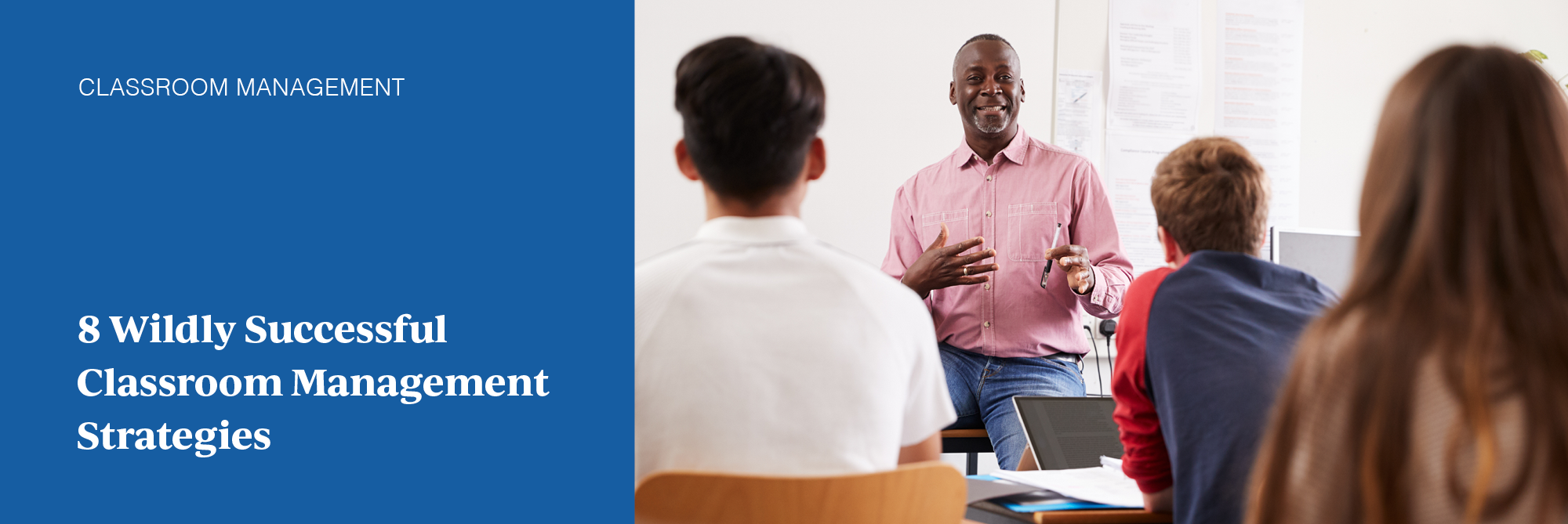Classroom Management | Teaching Strategies
8 Wildly Successful Classroom Management Strategies for 2024
Coming from a family of educators, Brad knows both the joys and challenges of teaching well. Through his own teaching background, he’s experienced both firsthand. As a writer for iCEV, Brad’s goal is to help teachers empower their students by listening to educators’ concerns and creating content that answers their most pressing questions about career and technical education.
Classrooms are changing. That change can come from a new generation of teachers, emerging technologies, student behaviors, or a combination of factors.
As a result, teachers’ classroom management strategies have changed as well.
If your classroom management techniques fall behind the times, you'll have a daily struggle to keep your students engaged.
In this article, we'll consider eight of the best classroom management strategies that’ll help you govern your classroom and teach your students in 2024:
- Show enthusiasm
- Create first-step compliance
- Prepare
- Master transitions
- Foster collaboration
- Practice follow-through
- Remember to play
- Start a “tech off” policy
After reading this post, you'll be better equipped to face everyday challenges in your classroom.
1. Show Enthusiasm

Enthusiasm is arguably the most important quality a teacher can have. Bringing an excited attitude to your classroom improves student interest, participation, and even learning.
Presenting yourself — and your lessons — with energy and poise is a sure way to draw students’ attention. It’s effective because you establish that you’re the focal point whenever you’re at the front of the class.
This is because teacher enthusiasm doesn’t always have an effect on behavior. But it does play a strong role in cognitive and emotional engagement.
Qin Zhang of Fairfield University noticed this in a controlled classroom environment. Zhang observed that some students may behave in class because of rules, grade incentives, or other external factors.
But just because they’re behaving doesn’t mean they’re learning. Instead, Zhang points to a concept called “emotional contagion” — the spread of an emotion that someone displays — to credit better student learning.
In a nutshell, students feel the enthusiasm of the teacher, which improves their attention, engagement, and stimulation.
This is why enthusiasm helps student learning. Enthusiasm won’t make rowdy students behave well — but it does hold their attention.
2. Create First-Step Compliance

First-step compliance lets you establish a start to your class period while immediately drawing student attention to you.
This idea is great for getting students engaged from the get-go of every class, and it’s surprisingly simple for how effective it is.
All you have to do is give your students an easy “task” at the beginning of class.
That task can be almost anything — but you have to deliver it as instruction.
These are some of the easiest (and most popular) first-step compliance tasks in use today:
- “Everybody’s eyes on me.”
- “Look at the screen.”
- “Point your eyes at the board.”
These super-simple instructions alert your students that class has started. They also start every class period with a quick accomplishment — kind of like how you can start your day with an accomplishment by making your bed.
It may not be a big deal, but it has significant results.
If you’ve ever seen a hypnotist on stage, you may recognize this style of instruction. It’s phrased the same way hypnotists issue commands to their subjects.
The key is to minimize complexity and emphasize action. Start your instruction with a strong verb — look, point, etc. — and follow it with a focus.
Looking somewhere is often the best instruction since most people pay attention to something as they look at it. With first-step compliance, you get every class off to a productive start.
3. Prepare Yourself

As any teacher can testify, teaching begins way before you step foot in a classroom: it starts with preparation. Even in the age of the internet, it’s impossible to overstate the importance of good, old fashioned prep work.
Getting ready for your classes makes all of them work more smoothly. You can plan for disruptions, create contingencies, and note areas for improvement. The more time you spend preparing, the fewer surprises you’ll have in the classroom. That’ll keep your students more focused and engaged.
When you’re prepared to teach, your students become eager to learn.
Preparation also plays a role in enthusiasm. After all, it’s easier to be energetic when you know what you’re going to do next.
4. Master Transitions

Transitions are key to a successful classroom. Most school class periods last somewhere between 45 and 90 minutes, depending on the school’s scheduling strategy. That means you’ll probably have to change gears at least once or twice every class.
Those transitions are crucial moments in every class. If you’re going to lose student engagement, it’s more likely to happen during a transition than any other moment.
Thankfully, it’s pretty easy to successfully transition from one topic to another.
In fact, you can transition in five simple steps:
- Signal for attention
- Say “in a moment”
- Give directions
- Say “go”
- Observe
It’s important to signal for attention so every student has their eyes on you. This step is similar to first-step compliance in that you grab attention with a short, easy-to-accomplish instruction.
The words “in a moment” are important as well. This tells students that instructions will be short and that they’ll be changing gears soon.
Directions form the core of a transition. This is where you’ll say what’s about to happen in as few words as possible. The shorter you can say it, the better.
Fourth, say the word “go.” As it turns out, “go” is a powerful word. It’s short, actionable, and universally understood. When you say it, students know they’re moving to the next task.
Last, it’s important to observe the student follow-through. Note where they fail and where they succeed so you can change your strategy for next time.
5. Foster Collaboration

Collaboration and group work has always been a staple of education.
The peer-to-peer nature of this teaching style gives students an opportunity to connect with one another. It also encourages relationship-building, which creates a more positive learning environment in your classroom.
Instituting collaboration in your classroom gives you a new teaching strategy with little work on your end. You can come up with expectations, goals, and deadlines, and then you can turn your students loose!
The only effort required on your part is to ensure groups stay on topic.
Collaboration doesn’t have to be face-to-face either. Thanks to massive strides in online applications, companies like Google offer collaboration software your students can use simultaneously.
In other words, there’s never been a better time to encourage collaboration in your classroom.
6. Practice Follow-Through

It’s important that your students respect you. That means they need to respect your word.
If you say you’ll do something, they need to trust that you’ll follow-through. This produces happy students, and it reinforces positive qualities like honesty, trust, and follow-through. The more your students see you keep your word, the more likely they’ll be to do it as well.
Passively, this structures your class in a positive, productive way. Students feel that your classroom is a place of kept promises and potential, both of which keep them motivated.
This is a simple idea. But it’s how you can lead by example to keep students engaged in your class.
7. Remember to Play

All work and no play makes students stressed out. In fact, American high school students are more stressed out than adults.
That may not sound significant — these days, we throw around the word “stress” so much that it’s hard to remember what such a small word actually entails.
But short-term stress has a major impact on the brain’s ability to learn. Long-term stress is even worse, to the point where it can impair minute details like cellular communication.
So when students say they’re stressed, they’re really saying they can’t learn.
That means it’s the responsibility of the teacher to take the edge off. Even if your class only has a five or 10 minute instructional pause, it can give them a break from direct stress.
You can reduce stress in the classroom by:
- Making jokes and encouraging laughter
- Fostering creativity
- Recognizing student accomplishments
- Gesturing to encourage engagement
- Staying positive
The most powerful method on that list is laughter. If you can make students laugh just once a day, it means they’ve forgotten about their stress — even if it’s for a moment. The results could change how much your students learn.
8. Start a “Tech Off” Policy

With the amount of technology available at their fingertips, there’s no question that students today are more distracted than any other generation.
Smartphones, tablets, and even watches are all culprits when it comes to distracting students. If you want to keep your students on-track as often as possible, you need a “tech off” policy.
You have a couple ways you can accomplish this.
First, you can force all students to remove the devices from their pockets, turn them off, and flip them (face-up) on their desks.
That lets you see who’s followed instructions. It works best when students place their smartphones in a very specific area of their work station — like the top right corners of their desks.
When you can see that devices are turned off, you can be sure students won’t be distracted by them.
Second, if you’re using tech in your classroom as well, you can institute a penalty for delayed work.
So if a student doesn’t finish their work on school computers before the end of the period, they have to finish their work on paper during the next class.
While this may not sound that threatening, it’s a serious motivator for the digital native generation. They’ve grown up with borderline-unlimited access to screens.
If you take those screens away, they often feel like something is missing.
Third, you can institute more direct penalties, such as deducting points from their grade.
With one of these policies, you’re sure to find different degrees of success. You can always refine a strategy to make it more specific to your classroom, too.
It may take some trial and error, but every day will be another step in the right direction!
Keep Your Students Focused and Engaged
As a teacher, managing your classroom can be one of the most significant challenges you face every day. Between keeping students focused and on task and limiting distractions, ensuring your students are learning can be difficult.
Thankfully, these simple strategies can simplify classroom management and help your students succeed.
But effective classroom management is just one of the challenges you’ll face as a teacher.
To learn more about the most significant challenges teachers face and how to overcome them, download your free guide. You’ll discover how to handle challenges like meeting your standards, balancing technology in the classroom, and more.


